The Apple iPad Pro Review
by Ryan Smith, Joshua Ho & Brandon Chester on January 22, 2016 8:10 AM ESTBattery Life
Battery life is important beyond any doubt. No one wants a tablet or phone that can only spend three hours away from a charger before it dies, no matter how good the device is. While such battery life might be incredible for a desktop replacement or anything else that realistically spends most of its life plugged into a charger, mobile devices are usually carried on the go and used far away from a charger for significant amounts of time. Probably the ultimate example of this is travel, where one might use a tablet to watch movies and browse the internet for a few hours over the course of a flight.
As a result, a significant portion of our reviewing efforts are devoted to determining battery life. In order to quantify battery life, there are inevitably a lot of test cases to cover. Some people might spend most of their time in an e-reader app, others might spend most of their time playing games or similarly intensive tasks on their phones. There’s no real standard for usage, so a tablet that might last a day for one person could last a week. As a result, the goal of our testing is to provide a useful relative comparison. In order to do this, we attempt to equalize for variables like display brightness by setting all displays to 200 nits for battery life testing. Due to the inability to completely eliminate the variables that come with live network testing, we also use strong network reception with high throughput on LTE to ensure that things like power amplifiers are either at a low power setting or bypassed entirely.
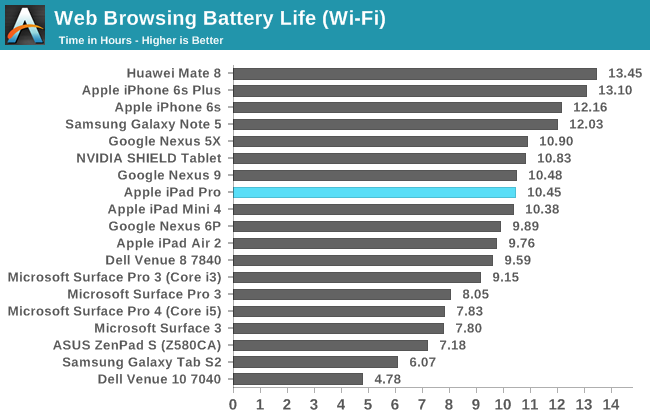
Our first test is the venerable web browsing test, in which we load a selection of web pages from full charge until the device shuts off from lack of battery charge. In WiFi battery life is pretty much identical to the iPad Air 2, which might be surprising given that the battery is only 41% larger. That might sound like a lot, but the display of the iPad Pro is 77% larger at the same 264 PPI pixel density, which means that there’s a pretty sizeable efficiency gap between the iPad Air 2 and iPad Pro. The improved display and SoC are likely to be the main reasons for this, as the 20nm SoC process that was used to make the A8 SoC was quite leaky due to its traditional planar transistor structure compared to the FinFET process used in the A9X.
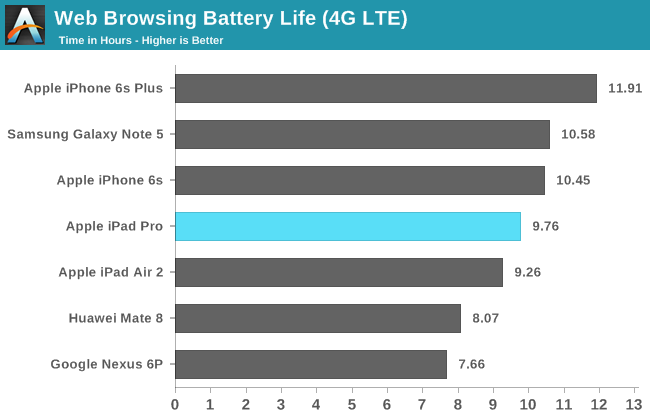
Interestingly, for whatever reason when re-running the same test on LTE battery life is noticeably different when compared to the iPad Air 2, where LTE and WiFi battery life were relatively close. I suspect that RF power is pretty similar between the two devices, but due to efficiency improvements on the display/SoC side the difference in battery life due to additional RF power consumption is magnified.

The more interesting test result that I encountered over the course of battery life testing was our tablet video rundown test. For whatever reason, web browsing clearly lasts a decent amount longer. It's pretty unlikely that the web browser has a lower SoC load when video is basically entirely dependent upon fixed function hardware decode. The most plausible explanation here for me is that we're seeing differences that arise from panel self-refresh, which can kick in on our web browsing test while the same definitely doesn't hold for our video test, which basically requires at least 30 FPS refresh rate continuously for the entire duration of the test. Overall that this makes the iPad Pro worse for content consumption, given Apple's content creation goals, is an unexpected turn of events.
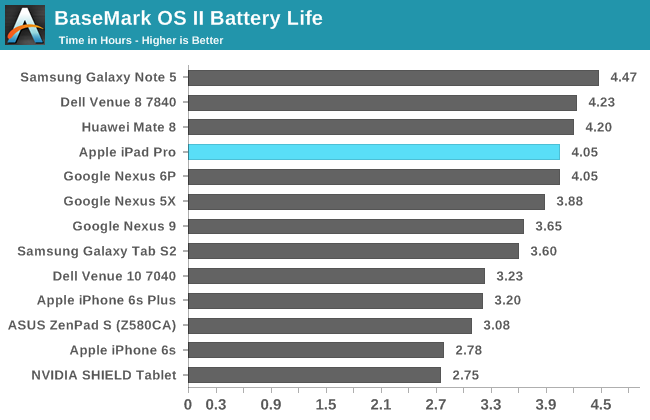
Moving on to the more SoC-bound tasks, we can start by looking at Basemark OS II, which is basically a CPU power virus that can be used to examine the upper bound for device TDP, in addition to nominal sustained CPU load. It’s evident from this test and some back of the envelope calculation that total device TDP excluding display power is roughly 5W, which is about right given the size of the device. This suggests that the A9X can be directly compared to Intel’s Core M in both performance and power, for better or for worse. Performance here is good, with relatively low throttling due to the use of a FinFET process and solid implementation of the Twister architecture.

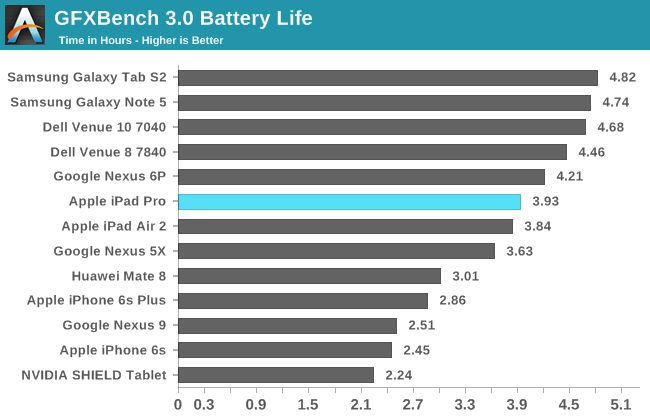
In our GPU throttling test, the A9X has effectively made it impossible to actually use T-Rex as a throttling test as it’s essentially pegged at vsync for the entire duration of the test. The iPad Pro also lasts a similar amount of time here as on the Basemark OS II test, which suggests that this test is still reaching TDP limits for the GPU, even if it doesn't manifest in the form of reduced performance.
Charge Time
While battery life is important, any time you’re dealing with a mobile device the time it takes to charge the battery is important as well. The usual example here is travel, but simply forgetting to plug in a device overnight can show the importance of charge rate. In the case of the iPad Pro, Apple ships it with their usual 12W charger. One might be tempted to suggest that the battery would be charged in about 3.5 hours, but it’s necessary to get the data and avoid speculation on something like this. In order to test how quickly the iPad Pro charges, we measure the difference in time between first plugging in a fully discharged tablet and when the charge is complete based upon power draw at the AC adapter.
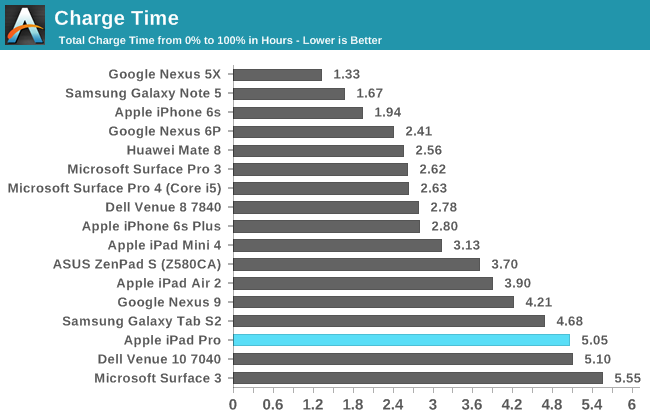
Interestingly, the iPad Pro takes a pretty significant amount of time to charge, at over a full hour longer than the iPad Air 2. While some might be okay with this, it’s definitely a sore spot for the iPad Pro as a higher voltage charger would be able to charge the device at a more acceptable rate. I’m not really sure why Apple decided to go this route, but there’s really no clear solution here unlike the case of the iPhone 6s Plus. The charger also definitely isn’t enough to ensure that you’re always charging the iPad Pro while in use either if the SoC is in overdrive/turbo states as thermally constrained power draw is already around 9-10W.
Despite the long charge time, overall the iPad Pro is quite mobile. However, it does regress somewhat relative to the iPad Air 2 due to its longer charge time, even if battery life is equivalent. Depending upon your use case though it might be difficult, if not impossible to tell the difference.











408 Comments
View All Comments
FunBunny2 - Saturday, January 23, 2016 - link
-- It's by now become a quasi-religious belief system for some that "mobile devices cannot ever be used for any professional purposes whatsoever!".despite what some think, Apple didn't invent the tablet. warehouses and manufacturers (when the US had them, of course) have used tablets with 802.11, and earlier protocols, for decades. all Apple did was create a consumer version.
Constructor - Saturday, January 23, 2016 - link
A "version" which "consumers" (apparently intended as a belittling epithet by you) can use, but the whole point is that it's not limited to that.akdj - Monday, January 25, 2016 - link
"You will still never be able to fit Photoshop's whole interface and abundance of options and menus into the tablet in a way that the user is easily able to reach them, without scrolling through pages of big buttons."Huh. Wonder why folks. The professional ones, for years have been buying Wacom tab companions to their 'workstation' specifically FOR PS, And EXACTLY for the reasons you outline, the ability to have precision touch and capacitance/tactile feel and response of real pencil or pen to paper. Some of these Wacom Photoshop controllers cost several times the price of the iPP for YEARS, & the iPP has its computer built in! No need to add a 'workstation'
You must've been hiding under a rock the last ½ decade. You've CERTAINLY not visited the App Store in some time. Adobe, Autoideskk Microsoft and the BIGGEST makers of "Content Creation" software are currently devoting MORE resources to mobile programming and development than their 'workstation' counterparts.
The 'big brow box' filled with diseases,; viruses - malware, adware, & the ilk's days are numbered. They're already on their way out of MANY folks' homes and offices being replaced by ultra books, passively cooled and ultra low voltage with ultra high efficiency is all the rage today. Battery life > 5 extra FPS, usability and funtionality > pure power, lotsa RAM, and expensive CPU and GPUs. Portability and the ability for 'instant on' access to their tab or phone > waiting til home, turning the power on, waiting for the boot. Opening PS (a slowly dying program with a phenomenal amount of alternatives on an iPad and iPhone and iDevice -- been that way for years, now with Adobe on board, their CreativeCloud suite offers a plethora of companion apps capable of ALL CS6's abilities as it's designed to aggregate and integrate with 'your' CC assets allowing for MOST editing ANYone will ever need on the iPad ...especially now with the display's ability to work with such an excellent active stylus and it's near direct comparison to Wacom's line of ...apparently unnessasary PS instruments and tools over the last decade or two those 'productive individuals' have made many millions of dollars in publishing? Now an AIO system with its OWN computer built in - a massive community of developers, independent to Adobe, friend next door or Autodesk themselves --- any software company interested in future survival in the industry is devoting more resources than ANY point in history to mobile dev. It's why MS, Adobe and AD were all there at the iPP unveiling. ALL demonstrating some phenomenal --- and yes, PROfessional use-case applications and software. I'm not a doctor but downloaded the examples shown at its unveiling of the Human Body atlas and AutoCAD --- its mind blowing how easily and flue to the iPad is able to manipulate such extensive detail and graphic overlays (nervous, muscular, skeletal, circulatory system overlays --- in any combination and with the ability to manipulate the direction you're looking at at a consistent 60fps) are MUCH better teaching aids - and learning that ANY static text book
Whether you ARE creating, flying a jet filled with passengers, entertaining a couple thousand folks at a concert, controlling inventory or filing your flight plan a personal pilot --- and probably 100,000 other occupations have been made significantly easier to accomplish, with less weight, more time away from the charger and 110v. That's what people need, want and are looking for. Unfortunately for Apple, they're making their iPad 'too well' --- as I've got the original, and an iPad 2 that both work, hold a charge and last as long as the Day I bought them six and five years ago respectively this year.
I also own the Air 2 and iPP and both have significantl impacts on my business I've run for nearly thirty years, successfully and exponentially dropping 'weight' every decade or so with something as capable as the always on, always connected and never a concern with battery life --- as the iPad is, easily replaces hundreds of dozens of crates of vinyl records! All while weighing about as much as a single - double record LP.
So, to summarize at the end of the day if you're a Photoshop user, you just got an incredible tool to augment your worlflow, make your photographic post production easier, organization and metadata handling, batch alteration or editing and aggregation of your library, metadata in tact and ready for post when you get home. No more off loading memory cards, organizing memory cards, redundantly dumping them for redundant/backup purposes and all the other BS that goes into using a dinosaur of a program FEW truly NEED for their projects.
Today, Adobe offers a ½ dozen "Photoshop" apps on iOS. Along with drawing, marking PDFs, even Premier and AE capture and integration (w/motion) - the options are becoming more extensive everyday, Adobe's just rewrote their entire app library and replaced each app for even better continuity for those still needing PS's tools or Acrobat's abilities beyond the $3, $5, $10 alternatives ...some, like Pixelmator, cross platform with ANY & EVERY PS tool the average layman could dream of --- available - @ the cost of a single month rental of PS/Lightroom 'rental'. And not just for hobbyists. Spend some time at DPreview.com to see the PS competition OR see Adobe's subscription tactics to maintain revenues.
It's not just a super powerful tablet. It's that and so much more thanks to an extensive and larger library of accessible software already matured to the point the App Store is - all in one place and all reasonably priced. Best prices and selection of software in history is currently more convenient and organized than ever and it's in the App Store
As devs have only had single GB of RAM, slower SoCs and smaller displays to program to over the last six years, even the Air 2 & 6s line of iPhones seems HUGE right now with double the RAM, graphics and compute. Double it again and you've got tether iPP. I'm already seeing apps available for Air 1/Mini 2 - 5s or A7/64bit iPads and newer to run the app.
As a daily user of the iPP for two months --- so many of your goofy statements make no sense, shout ignorance and beg to be straightened out --- but there's always a few schills around these parts beating an incredible product down while the masses of us are enjoying it!
Silly Murloc. What is it that makes YOU a Pro, and why is it YOUR job wouldn't be made easier or convenient with a tablet?
jlabelle - Thursday, January 28, 2016 - link
" now with Adobe on board, their CreativeCloud suite offers a plethora of companion apps capable of ALL CS6's abilities as it's designed to aggregate and integrate with 'your' CC assets allowing for MOST editing ANYone will ever need on the iPad"a very big big rant that just fall flat because of false premises. The claim above is a good example : simple case that most photographers need : Can I develop my RAW files on an iPad ?
When I mean developing, it is the normal basic reasons why you are shooting RAW in the 1st place : 1/ work in 16 bits mode so that you can push shadows / pull highlights and work on color without posterization ; 2/ apply automatically the lens correction (distorsion, CA, vignetting, ...) and 3/ have a color managed workflow (take into account the color space of the RAW file, have a calibrated display...)
The answer is ... drums rolling : you can NOT.
And you do not need a CS subscription to do that on a Surface, you can just purchase once Capture One Pro, DXO Optics... what you want. So what you can do with a Windows tablet, you simply cannot on an iPad Pro.
This is just one example but the same is true for a list so long that it makes no sense to try argue against that.
Gastec - Monday, January 25, 2016 - link
A gamer you would know what Pro moniker means.It goes like this: "I'm a Pro, gamer or whatever" meaning "I'm a big shot, a slick, better and cooler that you". And that's what iPad means when it says it's "Pro" :)
KPOM - Friday, January 22, 2016 - link
What do we need all the ports for? Most people, even in offices, can get by with wireless networks and printing these days.xerandin - Saturday, January 23, 2016 - link
Quadro*rabastens23 - Friday, January 22, 2016 - link
"Performance is better than a high end workstation from 10 years ago, a system which was capable of running professional tasks which are still nowhere to be found on mobile platforms."That's sort of an odd claim - what are those tasks, exactly? And if it's not a performance issue, why do you need an iPad Pro to do them?
ddriver - Friday, January 22, 2016 - link
Design, engineering, content creation. Basically every scenario that involves making something professionally rather than consuming something.Nobody needs a ipad pro to do this, point is the device is powerful enough for such tasks, and it would be nice if there was the software for it, in order to make that device truly PRO as in useful to professionals and not "pro" as in an empty marketing BS.
lilmoe - Friday, January 22, 2016 - link
DUDE. Software is NOT the only thing the iPad "Pro" is missing for it to be a Pro tablet. Get this through your head.The hardware is lacking even if it were much more powerful. The OS is also lacking.